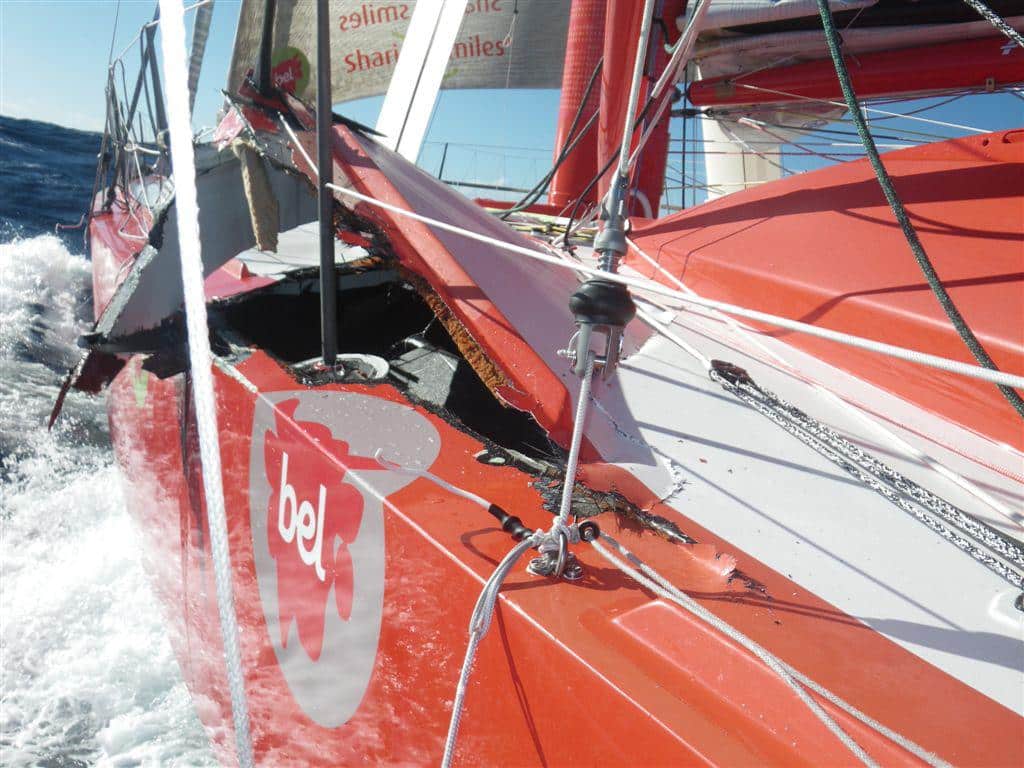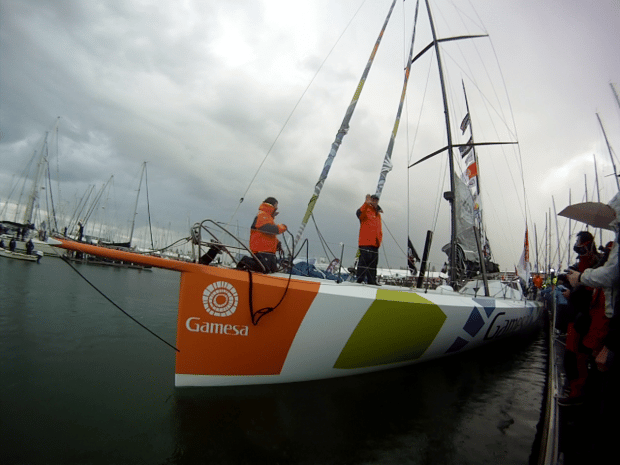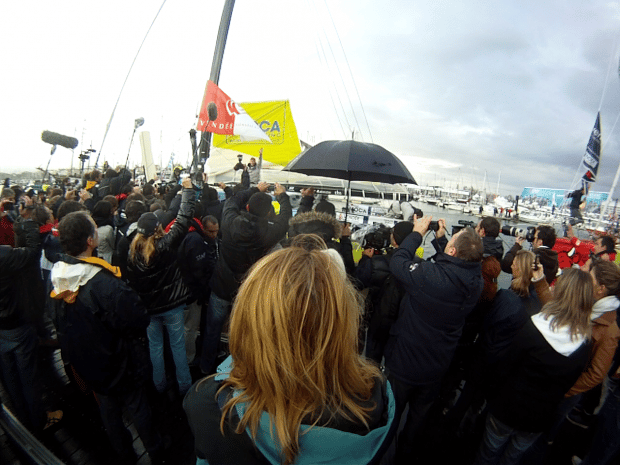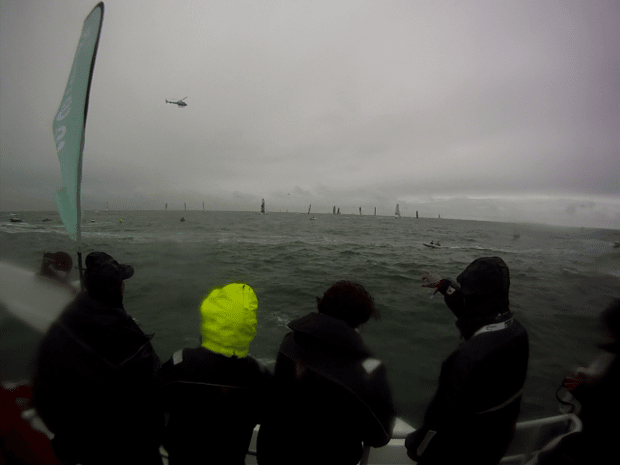
Groupe Bel
The Vendée Globe got off to a rough start as two of the favorites were forced to abandon the race less than 48 hours after the start. And yet, the drama is just beginning.
Still, breakages of this magnitude happened earlier than expected. Marc Guillemot’s Safran suffered severe keel damage probably due to flaws in the boat’s structural design, and he had to turn back Saturday. Early Monday, a fishing boat slammed into Kito de Pavant’s Groupe Bel off of the coast of Portugal, shattering the boat’s port-side outrigger and the bowsprit, while displacing the deck by over six feet.
Day 3 highlights – Monday, November 12, 2012 by VendeeGlobeTV
Mishaps so early in the race are certainly sad affairs, especially for the sailors and their ground crews, who have spent literally years in preparation of the Everest of all races. But then again, these are very likely just the first of many breakages to come during the 25,000-mile course. Needless to say, they are also minor incidents compared to the lives that have been lost during the race in years past.
The Vendee Globe’s legacy of danger and drama was already on my mind as I walked along the pier Saturday as the Vendée Globe sailors set off to sea one by one, ready not to set foot on land again until they had sailed the globe. I tried to fathom what adventures they would face, subsisting on freeze-dried food and two-hour sleep cycles as they made their way through the “Roaring Forties” and other more perilous spots on the globe’s water.

Mike Golding on Gamesa said he “felt like an American president” as he left the crowds behind on the dock Saturday morning en route to the Vendée Globe start line. Photo: Bruce Gain
I also wondered how different the ambience might have been at the dock as the boats set off during the first Vendee Globe in 1989. I thought about this as I watched Louis Burton (Bureau Vallée) kiss his baby goodbye and a crowd of television crews and reporters trying to sneak-in a last interview with François Gabart (Macif) as he prepared to cast off.
Among the obvious differences between now and then are today’s boat technologies, designs, and multi-million dollar budgets, but what else is different? I asked Jean-Luc van den Heede–who finished third and second, respectively, in the 1989-’90 and 1992-’93 races–what the start used to be like when I ran into him on the dock at the start of the race.
What was different during the first Vendée Globe races, van den Heede said, was that many of the crews were making last-minute changes to the boats in a panic. Comparatively, I only saw a couple of the teams (they also happened to be among the most poorly funded of the fleet) doing any kind of serious work on the boats hours before the start Saturday. Most of the sailors in the first Vendée Globes, like van den Heede, also had “real” daytime jobs, often unrelated to sailing, which is certainly not the case today. But what hasn’t changed, van den Heede said, was the passion the race stirs in the hearts of the French public.
“There were thousands lined up along the docks and canals at the start and finish of the first races, just as they do now,” van den Heede said.
What first made the Vendee Globe the national event that it is today was the voyeuristic element of the race, van den Heede said, when Philippe Poupon’s boat capsized off the coast of South Africa and his rescue made national news in 1990. Then, millions of French television viewers, tired of watching what was then some of the worst television programming in the Western world, got to follow the saga of Poupon’s dramatic rescue live on TV.

Television crews and reporters crowd around Francois Gabart (Macif) just before he cast off. Photo: Bruce Gain
Today, the mainstream French national news networks devote even more airtime to the race, offering real-time updates about breakages and other mishaps. I learned more details about the keel damage on Guillemot’s boat the next morning from a news broadcast on a mainstream French radio station; the incident made the headlines along with news about the Syrian rebellion.
Locally, for the start of the race, more than 300,000 visitors converged on Les Sables d’Olonne, France, just to get a brief glimpse of the sailors as they left port Saturday, to visit the Vendée Globe Village, and to see the IMOCA boats from afar. Many had camped out along the canal leading from the port in the rain and November cold long before dawn to have a direct view of the boats as they sailed past. The balconies of high-rise vacation apartment complexes and hotels were packed with fans, from which banners were hung. When Arnaud Boissières (Akena Vérandas), who lives at Les Sables d’Olonne, sailed by, tens of thousands of fans cheered him on more loudly than they did for the other sailors. In many ways, the atmosphere was more like that of a World Cup soccer game than any yacht race that I have ever watched.
There is a lot of speculation about why the race strikes such an emotional cord with the average person in France. Some say it is because the race is an expression of individualism and independence; this is personfied by skippers who rebel against the system in many ways by deciding to sail around the world alone. The simplicity of the race also helps to explain its wide appeal: understanding the basic rule that the sailor who is first to take their boat around the world from Les Sable d’Olonne and back does not exactly require a steep learning curve to understand. But these qualities of the race can also hold appeal to anyone from any country or culture, which does not help to explain why the Vendée Globe is so wildly popular here.

The start of the Everest of races from afar. Photo: Bruce Gain
Regardless, there will certainly be more than enough thrills and drama during the great race in the coming weeks and months to capture the imagination of millions of French fans as it has done for the past two decades. Why its popular appeal is so largely confined to France remains a mystery to me.
For more on the Vendée Globe:
Read Bruce Gain’s blog on who will win the Vendée Globe.
Find out more about the race.
View photos from the start of the Vendée Globe.









